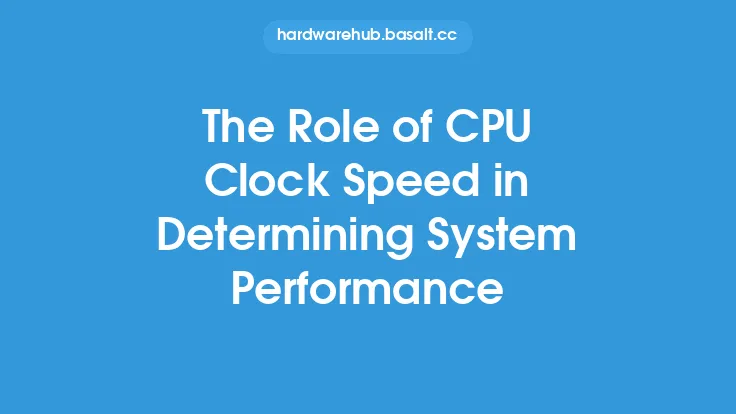The clock speed of a CPU, measured in GHz (gigahertz), is a fundamental aspect of its performance. It represents how many instructions the CPU can execute per second. A higher clock speed generally indicates better performance, as the CPU can process more instructions in a given time frame. However, the relationship between CPU clock speed and system responsiveness is more complex than a simple one-to-one correlation.
Introduction to System Responsiveness
System responsiveness refers to how quickly a computer system reacts to user input. It encompasses various factors, including the time it takes for applications to launch, for windows to open and close, and for the system to respond to keyboard and mouse inputs. While CPU clock speed plays a significant role in system responsiveness, it is not the only factor. Other components, such as the amount of RAM, the type and speed of storage (HDD vs. SSD), and the efficiency of the operating system, also contribute significantly to the overall responsiveness of a system.
The Impact of CPU Clock Speed on System Responsiveness
A higher CPU clock speed can significantly improve system responsiveness by allowing the CPU to execute instructions more quickly. This is particularly noticeable in applications that are heavily dependent on CPU processing power, such as video editing software, 3D modeling tools, and compilers. In these scenarios, a faster CPU can reduce the time it takes to complete tasks, making the system feel more responsive. However, for general use cases like web browsing, email, and office work, the difference in responsiveness due to CPU clock speed may not be as pronounced, especially if the system is already sufficiently powerful for these tasks.
Interplay with Other System Components
The effectiveness of a high CPU clock speed in enhancing system responsiveness is also dependent on other system components. For instance, if a system has a very fast CPU but is paired with a slow hard drive and insufficient RAM, the overall responsiveness may still be lacking. This is because the system might spend more time waiting for data to be loaded from the disk or waiting for memory to become available than it does executing instructions. Thus, for optimal responsiveness, it's crucial to have a balanced system where no single component is significantly bottlenecking the others.
CPU Architecture and Instruction Level Parallelism
The architecture of the CPU itself also plays a critical role in determining system responsiveness. Modern CPUs often feature technologies like instruction-level parallelism (ILP), which allows them to execute multiple instructions simultaneously. This can significantly improve performance and responsiveness, even at lower clock speeds. Additionally, advancements in CPU architecture, such as the introduction of more efficient instruction sets (like AVX-512) and better branch prediction, can enhance the CPU's ability to execute instructions quickly and efficiently, contributing to improved system responsiveness.
Power Consumption and Thermal Design
Another aspect to consider is the power consumption and thermal design of the CPU. Faster CPUs typically consume more power and generate more heat. If not properly cooled, this can lead to thermal throttling, where the CPU reduces its clock speed to prevent overheating, potentially negating the benefits of a high clock speed in terms of responsiveness. Thus, the design of the cooling system and the power supply unit (PSU) are critical in maintaining the performance and responsiveness of a system with a high-clock-speed CPU.
Conclusion
In conclusion, while CPU clock speed is an important factor in system responsiveness, it is part of a larger equation that includes other system components, CPU architecture, and the specific demands of the applications being run. For most users, a balanced system with a decent CPU clock speed, sufficient RAM, fast storage, and an efficient operating system will provide the best responsiveness. As technology continues to evolve, the relationship between CPU clock speed and system responsiveness will likely become even more nuanced, with advancements in areas like CPU architecture and storage technology playing increasingly significant roles.





